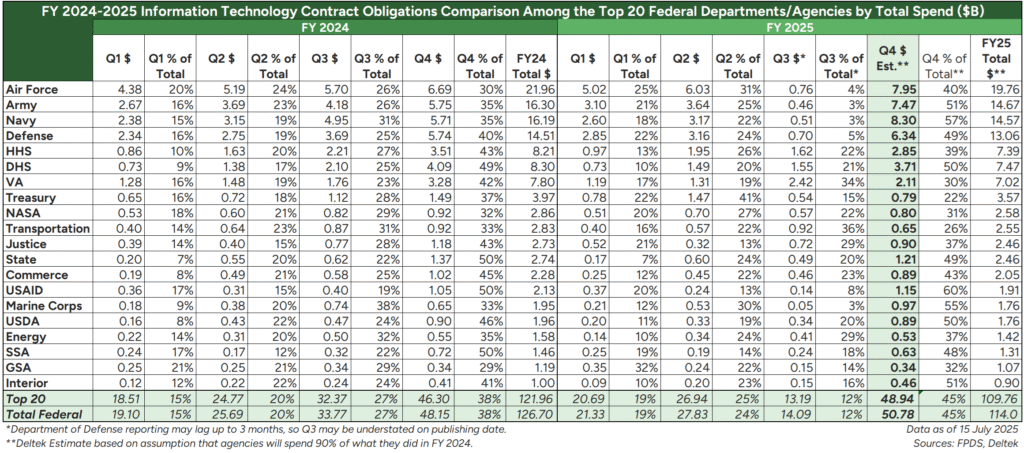Are We on Track for a $50 Billion IT Spend in the Fourth Quarter of FY 2025?
As a small to medium-sized business (SMB) interested in contracting with the U.S. government, understanding the upcoming trends in federal IT spending can provide valuable insights into the opportunities for your business. Federal agencies are increasingly relying on commercial information technology (IT) solutions to enhance their operational efficiency. With projections suggesting that federal IT spending could exceed $50 billion in the fourth quarter of Fiscal Year 2025 (FY 2025), it’s crucial to understand how these trends might impact your business.

The Current Landscape of Federal IT Spending
In recent years, federal IT budgets have expanded significantly as agencies seek to modernize their operations. However, this growth has not come without hiccups. Many agencies have faced budget delays due to continuing resolutions (CRs) from Congress, which can disrupt spending patterns. FY 2025 has already shown signs of these challenges, making it essential for businesses like yours to stay informed about potential funding shifts.
Here’s a shortlist of IT contracts:
OpenAI
- Department of Defense prototype contract: In June 2025, OpenAI was one of four companies to receive an individual contract worth up to $200 million from the Pentagon’s Chief Digital and AI Office (CDAO). The two-year deal is for developing and prototyping advanced AI tools for national security applications.
- GSA civilian access: In August 2025, the U.S. General Services Administration (GSA) added OpenAI, Google, and Anthropic to a multiple-award schedule, making their AI solutions readily available to federal agencies. The GSA announced that agencies can access ChatGPT Enterprise for a nominal $1 per agency.
- “OpenAI for Government” initiative: Also in June, OpenAI launched a new initiative to expand its work with government clients, including the Department of Defense, Air Force Research Laboratory, NASA, Los Alamos, and the Treasury Department.
Palantir
- $10 billion Army enterprise agreement (August 2025): Palantir secured a 10-year, $10 billion contract with the U.S. Army. The deal consolidates 75 existing contracts into a single enterprise agreement for software and data services.
- ICE contract extension (October 2025): The Department of Homeland Security’s Immigration and Customs Enforcement (ICE) awarded Palantir a $29.9 million task order to continue supporting the ImmigrationOS program.
- U.S. Treasury contract (September 2025): Palantir was awarded a contract with the U.S. Treasury to support its IT modernization agenda and improve data integrity at the IRS.
Anduril
Purely or primarily IT and software contracts:
- Army Next-Generation Command and Control (NGC2) prototype ($99.6 million): This contract is for a command-and-control system, which is inherently IT-related. The contract involves integrating Anduril’s software into the Army’s network, although the Times of India has flagged “fundamental security issues” with the platform.
- Air Force Thunderdome prototype project ($99 million): This contract is explicitly for the use of Anduril’s Lattice software for prototyping projects. Lattice is a software platform designed to connect sensors, weapons, and platforms.
- CDAO Edge Data Mesh production contract ($100 million): In December 2024, Anduril was awarded a contract by the Pentagon’s Chief Digital and AI Office (CDAO) to scale its “edge data mesh” capabilities using its Lattice software. This is a purely IT software and data services contract.
Hardware contracts with significant software/IT components:
- Soldier Borne Mission Command (SBMC) mixed reality system ($159 million): This contract is for a mixed-reality system that fuses night vision, augmented reality, and AI into a single system. While it involves hardware (the headset), the core functionality is provided by Anduril’s AI and software, which provide situational awareness to soldiers. This represents a significant IT component.
- Transfer of IVAS contract from Microsoft ($22 billion estimated): This deal, which transferred the Integrated Visual Augmentation System (IVAS) from Microsoft to Anduril, involves both hardware and software development. The system relies heavily on software for augmented reality, networking, and data integration. Anduril is working to integrate its Lattice software with the IVAS system.
- Roadrunner and Pulsar deployment ($249.9 million): This contract involves the delivery of air defense systems. However, the efficacy of these systems is dependent on Anduril’s software, which allows for command and control and autonomous operations.
- Counter-UAS systems for Marine Corps ($642.2 million): The C-sUAS systems involve both hardware and software. Anduril’s software is crucial for operating and networking these counter-drone systems.
Xai
- Defense Department AI contract: In July 2025, Xai was one of four companies, along with OpenAI, Google, and Anthropic, to receive a contract worth up to $200 million from the Pentagon’s Chief Digital and AI Office (CDAO). The deal is for developing and prototyping advanced AI tools for national security applications.
- General Services Administration (GSA) agreement: In September 2025, the GSA announced a major agreement with Xai to make its Grok AI models accessible to federal agencies for only $0.42 per organization. The deal is for 18 months, running until March 2027, and includes access to Xai’s Grok 4 and Grok 4 Fast models.
Why is Q4 So Important?
Historically, the fourth quarter of the fiscal year is when federal agencies tend to spend a large portion of their budget. In FY 2024, for instance, the top twenty federal departments spent approximately 38% of their total IT budget in Q4 alone. This trend indicates that as we approach the end of FY 2025, agencies may be looking to finalize their spending, creating a prime opportunity for businesses to secure contracts.
Estimating Q4 FY 2025 IT Spending
Predicting exact figures for federal spending can be tricky, but we can make educated estimates based on current trends. For FY 2025, analysts suggest that if agencies continue to spend at 90% of their FY 2024 levels, we could see nearly $49 billion available for IT contracts in Q4. This estimate considers the spending habits of the top twenty agencies and the impact of continuing resolutions that have affected quarterly budgets.
To assist your business in navigating this complex landscape, we recommend keeping an eye on spending reports and aligning your offerings with the needs of federal agencies.
Understanding the Impacts of Continuing Resolutions
Continuing resolutions have a significant impact on how federal agencies plan their budgets. Delays in appropriations can push spending into later quarters, leading to a backlog of contracts that need to be fulfilled. As an SMB, understanding this cycle can help you time your proposals and outreach effectively. Agencies may be more willing to engage with new contractors and suppliers as they approach their year-end spending.
The Role of Legislative Changes
Recent legislative changes, including budget reconciliation bills, can also impact federal spending. For example, the One Big Beautiful Bill Act has introduced billions in appropriations to various departments just as Q4 approaches. While not all of this funding will go toward IT contracts, it creates an environment ripe for opportunities. Your business should monitor these legislative developments closely to identify potential avenues for engagement.
How Select GCR Can Support Your Business
At Select GCR, we specialize in helping businesses like yours navigate the federal contracting landscape. Whether you are a veteran-owned small business (VOSB), a service-disabled veteran-owned small business (SDVOSB), or classified under HUBZone programs, there are specific government benefits available to you. We can assist in identifying these opportunities and supporting your growth in government contracting.
We Help You Become a Sub to Prime Contractors
- Get a Unique Entity ID (UEI). This identifier is necessary for any company doing business with the federal government and is assigned through SAM.gov.
- Register in the System for Award Management (SAM.gov). This is a mandatory, free registration to be visible to federal agencies and potential prime contractors.
- Determine your NAICS code. Find the North American Industry Classification System (NAICS) code that best matches your company’s products or services. This helps contracting officers and primes find your business for relevant work.
- Create a capability statement. Develop a one-page business resume that clearly outlines your core competencies, qualifications, and past performance. This is a vital tool for marketing your business to prime contractors.
- Obtain any relevant certifications. If your business qualifies, secure certifications for small businesses, women-owned businesses, veteran-owned businesses, or those located in historically underutilized business zones (HUBZone). These can give you a significant advantage, as prime contractors often have subcontracting goals with these groups.
Resources to Get Started
To help you better understand and engage with federal contracting opportunities, here are some resources you might find useful:
1. Understanding Government Contracts – A thorough guide on how to navigate government contracts and what you need to know.
2. Funding Opportunities for SMBs – Information on specific funding programs available for small businesses.
3. Veteran-Owned Business Resources – Explore resources tailored for veteran-owned businesses.
4. HUBZone Program Overview – Learn about the HUBZone program and how it can benefit your business.
5. SDVOSB – Specific resources for service-disabled veteran-owned businesses.
6. Contracting Opportunities – A list of potential contracting opportunities currently available.
7. Market Research Reports – Access insights and data that can inform your business strategy.
Moving Forward
With the potential for a significant IT spend in the fourth quarter of FY 2025, now is the time to position your SMB for success in federal contracting. By leveraging available resources and understanding the dynamics of federal spending, you can effectively engage with government agencies and maximize your opportunities. Don’t hesitate to reach out to us at Select GCR for personalized support tailored to your business’s unique needs.
Conclusion
In summary, the upcoming quarter holds promise for those prepared to engage with federal agencies. The combination of legislative changes and an increase in IT budgets offers a unique opportunity for SMBs like yours. By staying informed and strategically planning your approach, you can tap into the vast potential of federal contracting. Let’s work together to ensure your business is ready to make the most of this opportunity.
Sources:
– GovWin by Deltek: Insights on federal contracting trends.
– U.S. Government Accountability Office (GAO): Federal IT budget reports.
– Congressional Research Service: Analysis on the impacts of continuing resolutions.



